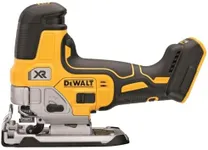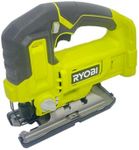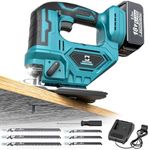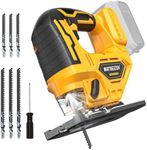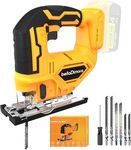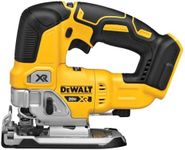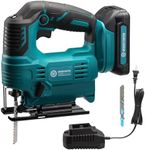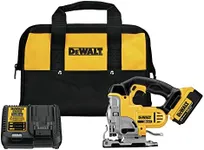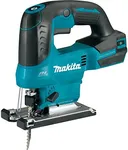Buying Guide for the Best Cordless Jig Saws
Choosing the right cordless jigsaw can make a significant difference in your woodworking or DIY projects. A cordless jigsaw offers the convenience of portability and ease of use without the hassle of cords. When selecting a cordless jigsaw, it's important to consider several key specifications to ensure you get the best fit for your needs. Understanding these specs will help you make an informed decision and choose a tool that will serve you well for years to come.Battery VoltageBattery voltage determines the power of the jigsaw. Higher voltage means more power, which is useful for cutting through tougher materials. Common voltages range from 12V to 20V. For light-duty tasks, a 12V jigsaw may suffice, while for more demanding projects, a 18V or 20V jigsaw would be more appropriate. Consider the types of materials you will be cutting and choose a voltage that matches your needs.
Battery LifeBattery life indicates how long the jigsaw can operate on a single charge. This is crucial for uninterrupted work, especially on larger projects. Battery life is often measured in ampere-hours (Ah). A higher Ah rating means longer battery life. For occasional use, a battery with 2.0Ah might be enough, but for extended use, look for batteries with 4.0Ah or higher. Think about how long your typical projects take and choose a battery that will last through them.
Stroke RateThe stroke rate, measured in strokes per minute (SPM), indicates how fast the blade moves up and down. Higher SPM allows for faster cutting, while lower SPM provides more control for detailed work. Jigsaws typically range from 500 to 3,000 SPM. If you need precision for intricate cuts, a lower SPM is better. For quick, rough cuts, a higher SPM is more efficient. Consider the type of work you do most often to determine the ideal stroke rate.
Orbital ActionOrbital action refers to the movement of the blade in a slightly circular motion, which can make cutting faster and more aggressive. Jigsaws with adjustable orbital settings allow you to choose between straight and orbital cutting. For smooth, clean cuts in delicate materials, use a straight setting. For faster cuts in thicker or harder materials, use a higher orbital setting. Choose a jigsaw with adjustable orbital action if you need versatility in your cutting tasks.
Blade Type and CompatibilityDifferent jigsaws are compatible with different types of blades, such as T-shank or U-shank blades. T-shank blades are more common and easier to change. The type of blade you use affects the quality and type of cut you can achieve. Ensure the jigsaw you choose is compatible with the blades you need for your projects. If you work with a variety of materials, look for a jigsaw that can accommodate a wide range of blade types.
Bevel CapacityBevel capacity refers to the ability of the jigsaw to tilt and make angled cuts. This is useful for creating beveled edges or cutting at specific angles. Most jigsaws offer a bevel capacity of up to 45 degrees. If you frequently need to make angled cuts, choose a jigsaw with an easy-to-adjust bevel feature. Consider the complexity of your projects and whether angled cuts are a common requirement.
Weight and ErgonomicsThe weight and ergonomics of a jigsaw affect how comfortable it is to use, especially for extended periods. A lighter jigsaw is easier to handle and reduces fatigue, while a well-designed grip can improve control and precision. If you plan to use the jigsaw for long sessions, prioritize comfort and ease of use. Test the feel of the jigsaw in your hand and consider how its weight and design will impact your work.
